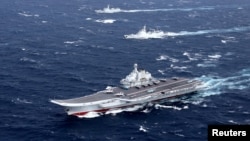Tight surveillance, experienced crews and the prospects of a multi-party code of conduct make the South China Sea relatively safe for marine shippers, including vessels such as the Iranian oil tanker that wrecked east of China this month, despite ongoing political friction.
Private vessels including oil tankers already use reliable charts while sticking close to shorelines where individual countries have granted passage, experts say.
Even if those ships enter a disputed tract of the 3.5 million-square-kilometer sea, increasingly sophisticated surveillance can pick up any accidents and the six governments with claims to it normally put humanitarian relief above sovereignty disputes, they say.
A code of conduct being discussed by China and the 10-member Association of Southeast Asian Nations (ASEAN) would make humanitarian relief a priority along with accident prevention, experts say. China and ASEAN, which includes four rival claimants to the South China Sea, agreed in November to work out the code this year.
“When it comes to this kind of humanitarian situation, very ironically it could actually induce these parties to set aside their differences for a few days or a few weeks and try to work together,” said Oh Ei Sun, international studies instructor at Singapore Nanyang University.
An Iranian oil tanker exploded into flames Sunday and sank in the East China Sea off Shanghai after hitting a Chinese cargo ship last week. Search crews have dimmed hopes of finding any of the tanker’s 32 crew members alive. Authorities are still looking for a cause of the accident.
China and Japan dispute tracts of the East China Sea. Japan’s effective control and China’s military flyovers to challenge it have strained relations.
Their tension has weakened the “atmosphere” that might otherwise enable China and Japan to handle accidents such as that of the Iranian tanker, said Huang Kwei-bo, vice dean of the College of International Affairs at National Chengchi University in Taipei.
Shared experience
In the South China Sea, a pathway for one third of the world’s marine shipping traffic, six governments vie for sovereignty. Goods shipped in 2016 were worth $3.37 trillion, according to estimates from the U.S. think tank Center for Strategic and International Studies.
Operators have the experience to avoid disputed waters where possible, said Collin Koh, maritime security research fellow at Nanyang Technological University in Singapore.
But during typhoons, high waves or the sudden passage of military vessels, shippers can still face disaster risks, maritime scholars say.
The number of claimants, along with their wariness of one another, however, have raised surveillance in the sea, allowing them to spot danger. Pirates and terrorists seldom occur in the South China Sea, unlike in other oceans, Huang said.
China, the strongest claimant with expanding control since 2010, routinely passes coast guard ships throughout the waterway. Now Beijing is building radar systems on as many as three islets in the sea’s Spratly archipelago, according to the think tank’s Asia Maritime Transparency Initiative.
China plans to launch 10 satellites over the sea from 2019 to 2021, Chinese state media say.
Safety versus sovereignty
Although the other claimants – Brunei, Malaysia, the Philippines, Taiwan and Vietnam – resent Chinese expansion into their maritime exclusive economic zones – they normally put aside disagreements in times of crisis, Koh said.
Accident prevention “is really the collective (responsibility) of everyone,” he said. “Governments usually issue notices to mariners and shippers on a real-time basis.”
Taiwan, which holds the largest Spratly feature, has rescued distressed ships from Vietnam, which holds nearby islets, coast guard officials in Taipei say. Taiwan said in 2015 that new construction on the island, called Taiping or Itu Aba, would be used for humanitarian assistance and disaster relief.
Elsewhere at sea, navies from the United States, which is not a maritime claimant, and Vietnam started an exchange in 2016 to head off unplanned hostilities among ships in contested Asia-Pacific waters, the U.S. military newspaper Stars and Stripes reported.
China and Vietnam, which got into a bitter boat-ramming showdown in 2014 over the placement of a Chinese oil rig, added a search-and-rescue component in 2016 to their decade-old joint naval patrols in the shared Gulf of Tonkin.
In August last year, both Malaysia and Singapore helped rescue people from a collision between the U.S. naval destroyer USS John S McCain and a Nigerian-registered tanker even though they disputed who controls the accident site.
Code of conduct
A code of conduct for the South China Sea would fine-tune accident prevention and emergency responses without touching the underlying sovereignty disputes, ASEAN officials said last year. It’s not clear whether the code will extend to private takers and cargo vessels, Huang said.
“I think to take disaster management or crisis management, and then for oil tankers to use that in the (code of conduct), that’s a very justifiable thing,” Huang said.
The code, based on a declaration by the Southeast Asian nations in 2002 but resisted by China until last year, will cover humanitarian relief, Koh forecast.
“I think this is one of those lower-hanging fruits that were already floated around amongst ASEAN as well as China on the South China Sea,” Koh said. “I don’t think this may be a big issue when it comes to the South China Sea, because I think first foremost the imperative is always a humanitarian approach to any such contingency before we talk about sovereignty and all other sort of issues,” he said.







